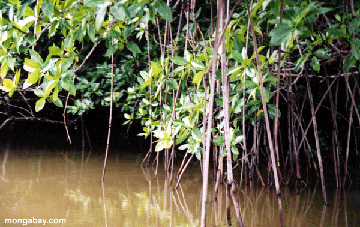Massive deforestation of mangroves may have worsened scale of disaster in Burma
Massive deforestation of mangroves may have worsened scale of disaster in Burma
Jeremy Hance, mongabay.com
May 13, 2008
Weeks after the devastating cyclone Nagris struck Myanmar’s Irrawaddy Delta on May 2nd, scientists and the media are debating the role in the scale of the disaster played by the region’s deforestation of mangroves. According to recent studies, mangrove forests act as a buffer against the effect’s of tropical storms like Nagris, though scientists don’t yet fully understand the relationship between storm mitigation and mangroves.
Mangroves are saline coastal forests that include heavy biomasses of trees and shrubs. Such forests are essential in protecting the coastal regions they surround from erosion, but they have also been shown to help mitigate the effects of tropical storms by buffering coastal communities against hurricane-like winds and tidal surges.
According to an article in the Wall Street Journal, the Irrawaddy Delta—where Nagris struck—lost 83 percent of its mangroves from 1924 to 1999. The deforestation of mangroves began with British colonial rule with their desire to turn Irrawaddy into one of the world’s most productive sources of rice. Yet, destruction continued through the democratic republic and the military regime that now rules Myanmar. Mangroves are still destroyed for coastal development and logging. Reports have also stated that the poor of Rangoon consume mangrove forests for fuel.
 Mangroves cleared for human settlement
|
Four days after the disaster Surin Pitsuwan, secretary general of ASEAN (Association of Southeast Asian Nations), spoke about the mangrove-effect in Irrawaddy. As reported by the AFP news, Pitsuwan said that increased population in the delta led to “encroachment into the mangrove forests which used to serve as buffer between the rising tide, between big waves and storms and the residential areas… All those lands have been destroyed. Human beings are now direct victims of such natural forces.” Pitsuwan was speaking in Singapore at the opening of a new center to deal with novel security issues such as climate change, new diseases, and environmental degradation.
The tsunami of 2004 brought home to many the importance of mangroves. As reported by the BBC, a study conducted by the IUCN found that mangroves in Sri Lanka may have saved thousands of lives. Two people perished in the tsunami in a village protected by mangroves and other vegetation, while a nearby village, lacking mangroves, lost 6,000 people to the tsunami. Such studies have prompted nations like India and Bangladesh to implement programs of replanting mangrove forests as buffers against natural disasters. Although, Bangladesh has the highest population density in the world, it has lost only 1 percent of its total forest cover since the 1990s and has actually increased its mangrove forests.
 Healthy mangroves. Photo by Rhett A. Butler. |
Myanmar’s deforestation rate is one of the bleakest in the world, and it’s not just mangroves. The military junta has increasingly pressed into Myanmar’s once untouched forests for logging, particularly of teak. Much of the wood is illegally exported to China. Between 1990 and 2005 Myanmar lost 18 percent of its total forests.
Many scientists see a direct connection between mangroves and their effect on mitigating the scale of storms. However the research of the connection is still young and much of it related to the 2004 tsunamis. It may be some time before scientists fully understand the full mitigation effects of mangrove, though their importance for biodiversity, erosion, and CO2 sequestering should also not discounted.
Related
Agriculture is primary driver of mangrove destruction
(10/31/2007) Agricultural expansion — not shrimp farming — is driving the rapid destruction of the world’s mangrove forests, reports a new study published in the Journal of Biogeography.
Mangroves more threatened than rainforests
(7/5/2007) Destruction of mangrove forests could leave the world deprived of their important ecological services by the end of a century, warns an international team of scientists writing in the July 6th issue of the journal Science.
Enthusiasm for tsunami-buffering mangrove projects waning
(12/19/2005) Research over the past year has shown that areas buffered by coastal forests, like mangroves, were less damaged by the 2004 tsunami than areas without tree vegetation. Accordingly, governments in tsunami-affected countries have proposed mangrove restoration projects along their coasts as a protective bioshield against storm damage.
Mangrove forests protected areas from 2004 tsunami says new study
(11/18/2005) A study released in late October shows that areas buffered by coastal forests, like mangroves, were less damaged by the 2004 tsunami than areas without tree vegetation. Last week the FAO reported that 20% of the world’s mangrove forests have disappeared since 1980.















